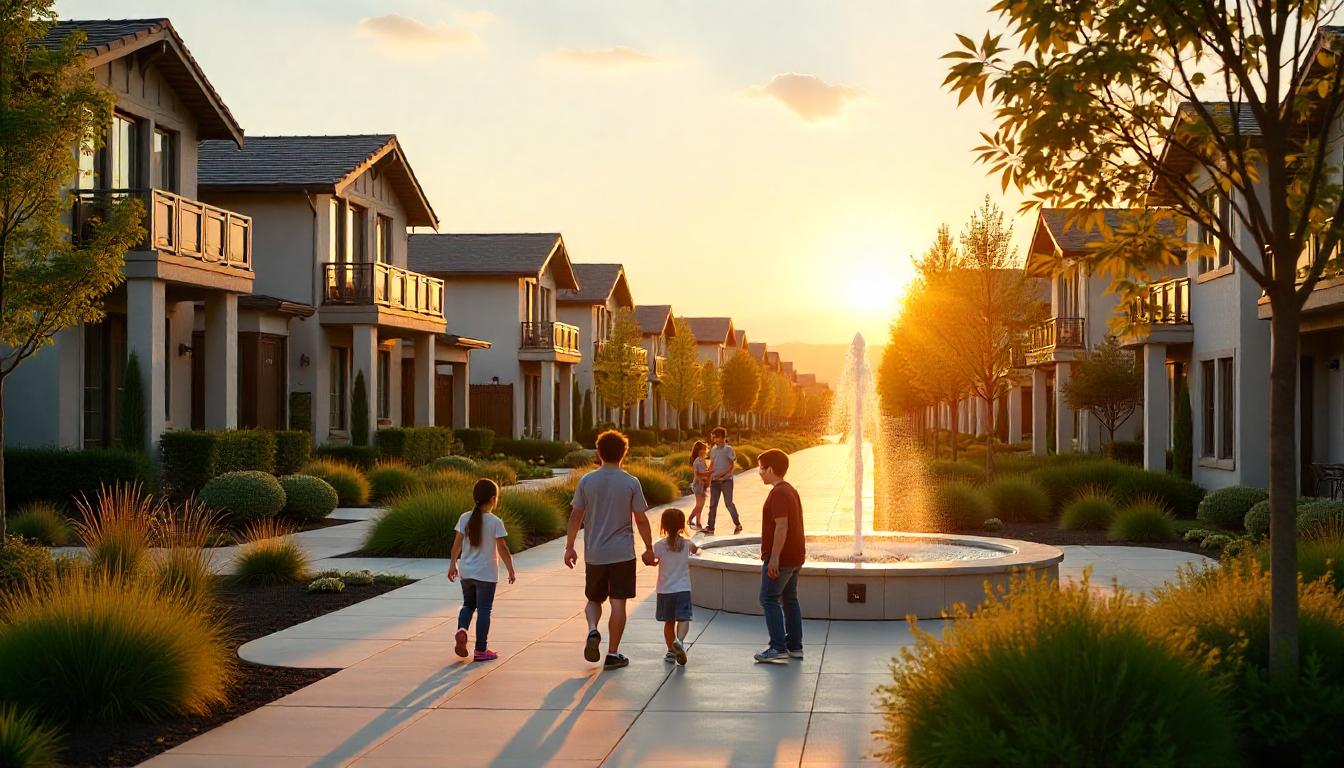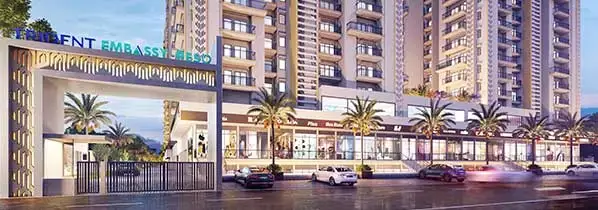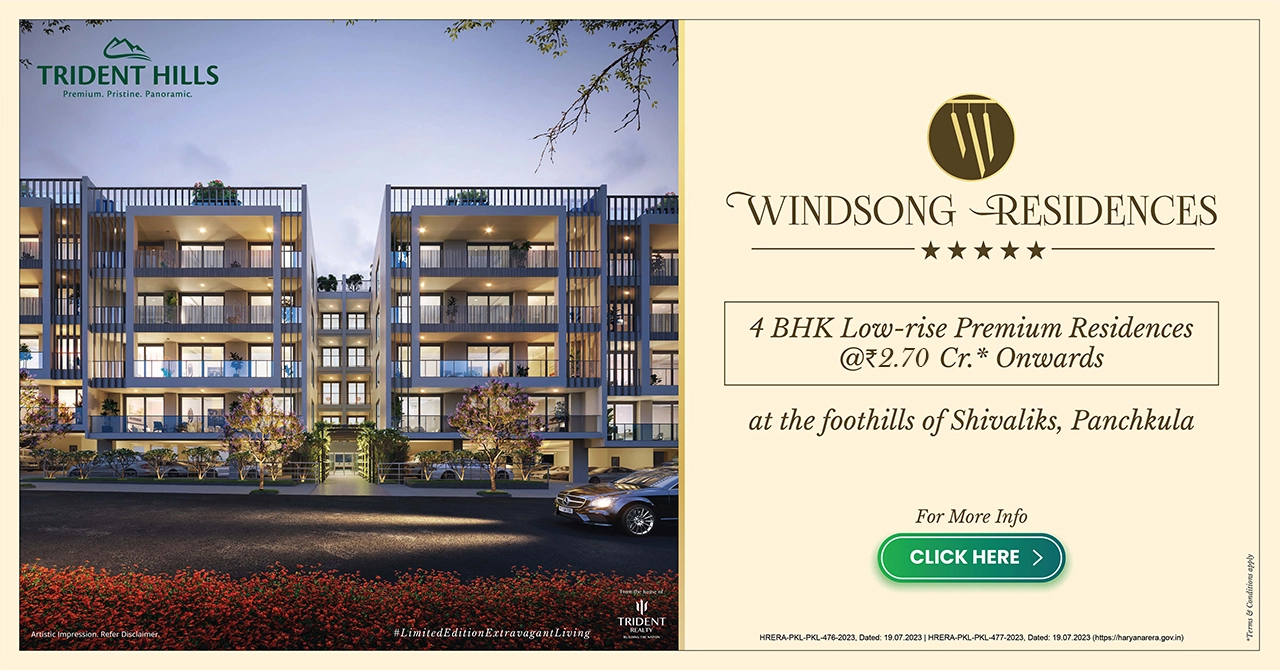
The New Benchmark in Sustainable Urban Living
A Vision for Tomorrow’s Cities
Imagine waking up in a vibrant community where the air is fresh, solar panels gleam under the morning sun, and children play in lush green courtyards that echo the warmth of India’s traditional lifestyle. This isn’t a distant dream but the emerging reality of sustainable urban living in India—a movement that’s redefining how we build, live, and thrive in our cities. As India races towards becoming a $5 trillion economy, with urban areas expected to contribute 70% of GDP by 2030 (IBEF Report), the need for self-sufficient, holistic communities has never been more urgent. Rapid urbanisation, coupled with environmental challenges, demands a new benchmark, one where homes are not just structures but ecosystems that nurture people and the planet.
At Trident Realty, we’re not just building homes; we’re crafting communities that embody sustainability, inclusivity, and innovation. This thought-leadership piece explores the shift towards self-sufficient, holistic urban living in India, delving into its environmental, social, and economic benefits, and how our projects are setting a new standard for the Indian real estate market.
The Urgency of Sustainable Urban Living
India’s urban population is projected to reach 590 million by 2030, up from 377 million in 2011 (McKinsey Global Institute). This rapid urbanisation presents immense opportunities but also exerts pressure on vital resources, with cities facing rising levels of pollution, water stress, and overburdened infrastructure. The construction and built environment sector is a major contributor to this challenge, accounting for 25–40% of total energy consumption and waste generation, and contributing nearly 40% of global greenhouse gas (GHG) emissions, according to the Indian Green Building Council (IGBC). In India specifically, the construction sector contributes approximately 22% of CO₂ emissions (India Energy Outlook 2021, International Energy Agency).
Against this backdrop, sustainable urban living is no longer optional, it is an urgent imperative for cities aspiring to be resilient, liveable, and future-ready.
Self-sufficient communities integrate renewable energy, efficient waste management, and green spaces to reduce environmental impact. Holistic design goes further, fostering social cohesion and economic resilience, ensuring cities are not just livable but thriving. Our vision aligns with this paradigm, drawing inspiration from India’s rich heritage of community living while embracing cutting-edge technologies.
Environmental Sustainability: Building for the Planet
At the heart of sustainable urban living is environmental stewardship. Green building certifications like GRIHA (Green Rating for Integrated Habitat Assessment) and LEED (Leadership in Energy and Environmental Design) are transforming India’s real estate landscape. According to the Indian Green Building Council, green buildings can reduce energy consumption by up to 30% and water usage by 20–50% compared to conventional structures. Our projects incorporate solar panels, rainwater harvesting systems, and energy-efficient appliances to minimise ecological footprints.
Take, for example, the use of renewable energy. Solar power, which India aims to scale to 280 GW by 2030 (Ministry of New and Renewable Energy), is a cornerstone of our developments. Rooftop solar installations not only power homes but also reduce reliance on fossil fuels, cutting electricity bills by nearly a third. Waste management is another focus—our communities employ composting units and recycling hubs, diverting up to 60% of waste from landfills, as seen in projects like GoodEarth’s eco-villages in Bengaluru.
Urban greenery is equally vital. Studies show that green spaces can reduce urban heat by 2–8°C (TERI, The Energy and Resources Institute). Our designs integrate vertical gardens, rooftop farms, and tree-lined avenues, creating microclimates that enhance air quality and resident well-being. These efforts align with India’s National Clean Air Programme, which targets a 20–30% reduction in particulate matter by 2024.
Social Cohesion: Reviving the Spirit of Community
Sustainable urban living isn’t just about buildings—it’s about people. India’s traditional mohallas and vataras, with their shared courtyards and close-knit communities, offer timeless lessons. Our projects draw on this heritage, designing spaces that foster inclusivity and connection. Shared amenities like community kitchens, co-working spaces, and cultural pavilions encourage interaction, breaking the isolation often found in modern urban settings.
For instance, our upcoming project in Panchkula incorporates a central plaza inspired by the traditional lifestyle, where residents can gather for festivals or daily conversations. Such spaces promote social equity, ensuring that people from diverse backgrounds, young professionals, retirees, or NRIs feel at home. Research from the Centre for Urban Equity highlights that inclusive community design can enhance mental health and reduce social disparities, a critical need in India’s rapidly growing cities like Lucknow or Kochi.
Consumer Trends: The Demand for Holistic Living
Post-pandemic, Indian homebuyers have shifted priorities. A 2024 CBRE survey found that 62% of ultra-luxury buyers expect personalised concierge services, while 80% prioritise modern clubhouses and green spaces. Millennials and NRIs, in particular, favour low-density planning, wellness zones, and walk-to-everything neighbourhoods. This is evident in the rise of suburban townships in cities like Lucknow, where Rishita Developers’ projects cater to mid-premium buyers with EV charging, rainwater harvesting, and co-working spaces.
The preference for ready-to-move-in properties from trusted developers reflects a focus on quality and reliability. The ANAROCK 2023 NRI Report highlights that 15% of all NRI real estate investments in India were channelled into the Tricity region. Buyers also value long-term savings, with green homes offering up to 30% energy reductions and 50% water savings, enhancing resale value.
Economic Viability: Sustainability That Pays Off
Sustainability is often perceived as costly, but holistic communities prove otherwise. Green buildings, while requiring higher upfront investment, yield significant long-term savings. A report by Knight Frank India notes that energy-efficient homes can reduce utility costs by 25–40%, making them attractive to India’s growing middle class, projected to reach 547 million by 2025 (Economic Times). Additionally, sustainable projects create jobs—construction of green buildings employs 20% more workers than traditional projects, boosting local economies (CII-IGBC Report).
Our developments integrate cost-effective solutions like modular construction and locally sourced materials, reducing expenses without compromising quality. For investors, sustainable properties offer higher returns, with green-certified buildings commanding 5–10% higher rental premiums in cities like Bengaluru and Mumbai (JLL India). By aligning with buyer preferences for eco-friendly homes, we’re not just building for today but investing in India’s future.
Technological Integration: Smart and Sustainable
Technology is the backbone of modern sustainable communities. India’s Smart Cities Mission, launched in 2015, aims to develop 100 smart cities with IoT-enabled infrastructure (Smart Cities Mission). Our projects embrace this vision, incorporating smart meters, EV charging stations, and home automation systems to optimise resource use. For example, IoT sensors can reduce water wastage by detecting leaks, saving up to 15% of water in residential complexes (TERI).
Electric vehicle adoption is rising, with India targeting 30% EV penetration by 2030 (NITI Aayog). Our communities include EV charging hubs, encouraging residents to embrace cleaner transport. These innovations not only enhance convenience but also position our projects as future-ready, appealing to tech-savvy buyers in Tier 1 and Tier 2 cities.
Policy and Market Trends: A Supportive Ecosystem
Government initiatives like the Smart Cities Mission and Pradhan Mantri Awas Yojana (PMAY) are driving sustainable urban development. PMAY aims to provide 20 million affordable homes by 2022, with a focus on eco-friendly designs (Ministry of Housing and Urban Affairs). These policies, coupled with incentives like tax breaks for green buildings, create a fertile ground for holistic communities.
Market trends also reflect growing demand. A 2023 survey by Anarock Property Consultants found that 65% of homebuyers in Tier 1 cities like Delhi-NCR and Bengaluru prefer sustainable properties, driven by environmental awareness and cost savings. In Tier 2 cities like Jaipur and Coimbatore, NRIs are increasingly investing in eco-friendly homes, attracted by long-term value and global trends like net-zero energy districts, as seen in Dubai’s Sustainable City.
Overcoming Challenges: Paving the Way Forward
Despite the promise, challenges remain. High initial costs for green technologies can deter developers, while regulatory hurdles slow adoption. However, solutions are emerging. Public-private partnerships, as seen in the Smart Cities Mission, can offset costs, while streamlined GRIHA certification processes reduce compliance burdens. Educating buyers about long-term savings—such as a 30% reduction in energy bills can shift perceptions, as evidenced by successful projects like Magarpatta City in Pune.
Our approach is proactive: we collaborate with local governments to navigate regulations and offer financing options to make sustainable homes accessible. By showcasing tangible benefits, like healthier living environments and lower maintenance costs, we’re building trust and driving demand.
A Vision for India’s Urban Future
The future of urban living in India lies in communities that balance ecology, equity, and economy. Imagine a neighbourhood where solar-powered homes coexist with vertical gardens, where shared spaces echo the warmth of traditional Indian villages, and where smart technologies ensure efficiency. This is the benchmark we’re setting at Trident. Our projects are not just residences but ecosystems that inspire sustainable lifestyles, fostering a sense of belonging and resilience.
Globally, models like Dubai’s Sustainable City, which achieves 50% energy savings through integrated systems, offer inspiration. In India, projects like Auroville’s eco-communities demonstrate how tradition and innovation can merge. By blending these insights with India’s unique needs, we’re shaping cities that are ready for the challenges of climate change and urbanisation.
Join the Movement
India’s real estate sector is at a crossroads. With urban dwellers projected to reach 600 million by 2035, the infrastructure built today will shape tomorrow’s cities. Integrated townships, with their focus on sustainability, self-sufficiency, and community, are not just a trend but a necessity. They align with India’s climate goals, enhance liveability, and offer robust investment potential.
At Trident Realty, we invite you to be part of this transformation. Explore our projects, designed to redefine how you live, connect, and thrive. Visit our website to learn more about our vision for eco-friendly homeownership and join us in building a greener, more inclusive future for India.









